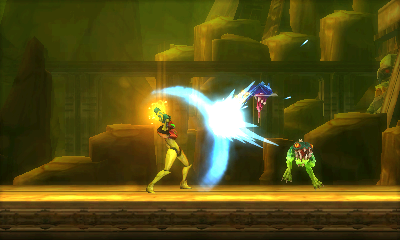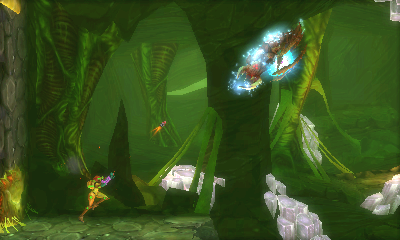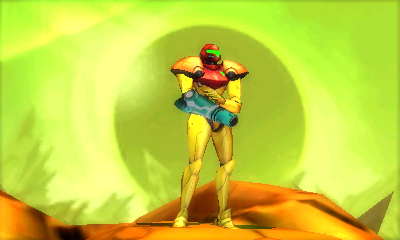It has been thirteen years since the last 2D Metroid game appeared on a Nintendo system. I became a fan of the series in 2004, just shortly after Metroid: Zero Mission released. Despite being a huge fan of the franchise, I have never had the opportunity to look forward to a traditional side-scrolling Metroid title, until now. Metroid: Samus Returns is a reimagining of the classic Game Boy title Metroid II: Return of Samus, which released back in 1991. By comparison, Samus Returns brings a much-required update, with environments redesigned from the ground up to match Samus’ enhanced arsenal of weapons and new abilities.

The game opens with a comic-strip-style recap on the Metroid story so far; where a Galactic Federation Research ship has retrieved a living sample from planet SR388, and was taken down by Space Pirates on its return voyage in order to use the power of the Metroids to take over the galaxy. This leads into the events of Samus’ first mission on planet Zebes and how she was able to thwart the Space Pirates’ plans, serving as a great introduction to new players who may not be familiar with the Metroid series. It concludes with the Galactic Federation identifying the threat that the Metroids continue to pose and coming to the realisation that Samus Aran must once and for all exterminate every one of them, including their evolved forms on their home planet SR388.
The controls of Samus Returns are relatively simple: you move Samus with the Circle Pad in eight directions, and when holding down the left trigger, you can aim in a full 360 degrees to fire your weapons with accuracy, which is a new and welcomed addition to classic Metroid. The face buttons allow Samus to jump and fire her weapon, and combining this with right trigger swaps the ammunition to missiles. As you progress through the game, different weapons can be selected on the touch screen and are easily accessible with your thumb. Thanks to the dual-screen nature of the 3DS, the minimap is always available on the bottom during gameplay, allowing you to see exactly where you are, including the locations of important equipment such as save stations and places where you can replenish your health or missiles. Map pins of different colors can be placed using the touch screen to remind you of points of interest to revisit later. I personally found these to be very useful for locating a stray missile expansion towards the end of the game, which I am sure I would have struggled with otherwise. Another helpful feature is the teleporters, which will allow you to travel around or between areas, making backtracking to previous areas much less tedious than in the original game. I think they are yet another handy addition that will help those who wish to complete the game with a one hundred percent clearance rate.
Samus is equipped with a Metroid radar to show how many of the deadly creatures are remaining on SR388. As Samus descends into the planet and gets closer to a Metroid, the radar will begin to beep, getting faster the nearer you get, a feature that made clearing up the remaining Metroids a much simpler task over the original. It was great to see how each Metroid could be approached and learning their different tells. I was impressed with how certain Metroids behaved differently and would make the most of their natural environment, such as dropping bombs into water to electrify it or crawling through gaps into different areas for Samus to hunt down. When you destroy a Metroid, you collect its DNA which can be returned to Chozo Seals located near hazardous acid. This acid will only lower once all Metroids in the area have been defeated, allowing you to progress deeper into the planet. Returning DNA to a Chozo seal will reveal the location of a nearby Metroid husk, giving you a good indication of where to go if you are struggling.

Our favorite bounty hunter also has a couple of abilities that are new to the series. The first is the Melee Counter, a powerful physical attack where Samus swings her arm cannon and hits a charging enemy in the face, putting it into a daze temporarily. She can then follow up the attack with a barrage of beam or missile shots to deal some serious damage and also show off some awesome moves in the process as the camera changes to a different perspective temporarily. While I was able to nail the timing of the Melee Counter almost immediately, there were missed opportunities where I struggled to hit a foe first time, and I feel it will take some players a bit of practice to execute it effectively on some of the tougher, more unpredictable enemies later in the game. My advice would be to listen closely for a sound prompt when a creature is about to charge at you, allowing you to successfully land the hit.
The second new addition to Samus’ arsenal is her Aeion abilities. There are four to collect, and each one will help you greatly in some way throughout your adventure. Aeion abilities are powered by Aeion energy, which can be obtained from killing enemies or recharging it at appropriate locations. You can increase the size of your Aeion energy meter by collecting tanks hidden around the planet. The Scan Pulse can be used to unleash a wave of energy that highlights breakable surfaces within your current location. It also reveals undiscovered areas of the map and any hidden items. Lightning Armor creates a protective electrified barrier around Samus that will shield her from some of the damage dealt by environment and enemies. It will also strengthen your Melee Counter. Beam Burst enhances your current beam weapon to unleash a barrage of shots to bring down enemies faster. Some enemies require the Beam Burst in order to be defeated, so be sure to keep your Aeion tank replenished.
The final Aeion ability is Phase Drift, which was my personal favorite of the four Aeion abilities. Phase Drift slows down time, and this has various uses. The most obvious one would be to dodge enemy attacks, but another clever application of it is to give yourself enough time to pass over fragile blocks before they break. This ability seems to have replaced the classic Speed Booster power which, as some Metroid veterans will be disappointed to hear, is not present in Metroid: Samus Returns. However, you can still move quickly through areas using a combination of Power Bombs and Spider Ball, and I am going to use this opportunity to coin the term “Spider Bombing”, which was a lot of fun once I realized it could be done. Overall, I feel the Aeion abilities are another great feature that will help players progress through the game but can be disregarded for those who want a more challenging experience, with the exception of Beam Burst, which is necessary to pass through some areas.
On a side note, I was pleasantly surprised by the amount of nods to Metroid Prime in the game. The scan visor was an essential tool in the Prime series, and the Scan Pulse Aeion ability seems to offer a similar role in this game. The Grapple Beam lets you pull blocks from some enemies and obstructing tunnels similar to the Grapple Lasso in Metroid Prime 3: Corruption. There are also several music arrangements taken straight from the Metroid Prime games or resembling them closely, such as the superheated areas (Magmoor Caverns), the item collection theme, and the theme that plays when you obtain a new Aeion upgrade. There is even an enemy that will send out a pulse of energy that disables Samus’ Aeion abilities temporarily, which is somewhat similar to the Rezbit in Metroid Prime 2: Echoes, where Samus is hacked and has to reboot her suit systems. Considering that the series producer Yoshio Sakamoto sees the classic and Prime games as separate things, it is great to see the two different types of Metroid game finally come closer together.
SR388 is a beautiful, vibrant planet, with environments filled with vegetation that is alive and breathing, awash with wonderful but deadly creatures. The two-dimensional side-scrolling game has evolved to include some terrific backdrops that move and break, which are further enhanced by turning up the 3D slider on your system. Nintendo 2DS owners are going to be missing out big time, as Metroid: Samus Returns is by far the best 3D experience I have ever played on the system. This was clear from the opening cutscene giving off a diorama effect but even more so later when I was freezing enemies and watching the shards of ice shatter out towards me. It felt like I could just place my hand through the screen and touch it, and I have not felt this excited about 3D since the 3DS first released six and a half years ago.
I am happy to report that the soundtrack for Samus Returns is a solid addition to the game that complements its eerie, isolated nature very well. Despite the original game not having a great deal of memorable music, I am pleased to say that many of the original themes have been included, along with some brand-new pieces and fan favourites from the past. Even the different Metroid evolutions have their own theme this time around, and the bits and boops of the less memorable area music from the original are peppered across some of the new compositions. Unfortunately, not every track from the original made it in, and I was disappointed that one theme in particular was replaced with a brand new composition, something I feel should have been brought up to date instead of being replaced. I was surprised to see that the game had been composed by Daisuke Matsuoka, a musician new to the Metroid series under the direction of veteran Metroid composer Kenji Yamamoto, with sound coordination by Minako Hamano. The music of Metroid is something I am incredibly passionate about, and I certainly would not object to hearing more from Matsuoka-san in future games!
Sadly, not all games are perfect, and I do have a couple of minor complaints. While I accept that Samus Returns is aiming to appeal to new fans as well as old, I appreciated how scarce missiles were in the original game, which encouraged you to use them sparingly. Samus Returns has recharge stations everywhere, which removes something special in my opinion. Checkpoints are also a feature in this game that make save stations redundant and encourage the player to be more careless in their approach.
Metroid: Samus Returns is the traditional 2D Metroid title I never thought we would see again. It features the backtracking, isolation, and atmosphere that are at the core of the Metroid franchise. The collaborative efforts of Yoshio Sakamoto and the team at MercurySteam are nothing short of exceptional; they have created a solid title that Metroid fans have been screaming for all these years but also a title that newcomers are going to be able to grips with quickly. The game certainly opens the doors to future Metroid installments, and I hope that Nintendo will consider working with MercurySteam in future games, as they clearly understand what a Metroid game is all about. Perhaps it is finally time for the sequel to Metroid Fusion?
After playing Metroid: Samus Returns, I consider myself incredibly fortunate and lucky to be a Metroid fan. Samus has well and truly returned!
Review copy provided by Nintendo UK


